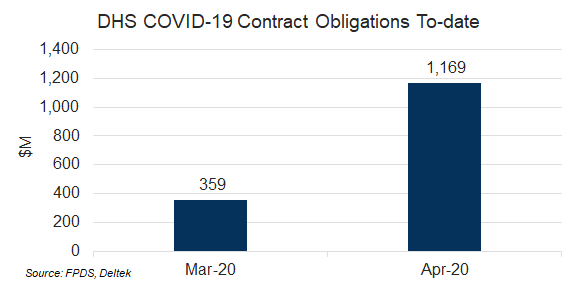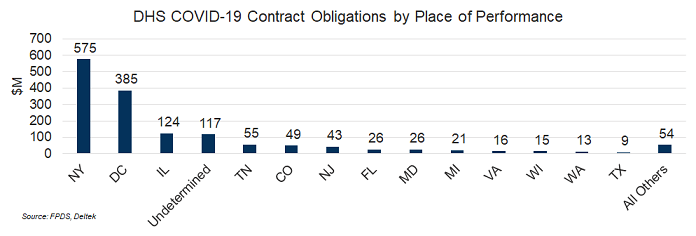Highlights of the Department of Homeland Security CARES Act Spending To Date
Published: May 05, 2020
Federal Market AnalysisArchitecture, Engineering, and Construction (AEC)Contract AwardsCoronavirus (COVID-19) PandemicDHSSpending Trends
Contract spending data shows how the Department of Homeland Security is using the funds that Congress provided for COVID-19 response efforts.
Key Takeaways
- The CARES Act provided the Department of Homeland Security (DHS) with more than $45.8 billion for COVID-19 response activities – primarily to the Federal Emergency Management Agency (FEMA) for its lead role in the federal COVID-19 response.
- From March to April 2020, DHS has obligated more than $1.5 billion in COVID-19-related contracts with spending in April picking up considerably over March as CARES Act funding begins to flow. All but 2% of these contract dollars have flowed through FEMA.
- Nearly 90% of DHS contract spending to date has been focused on the areas of Architecture Engineering and Construction; Medical and Scientific Equipment; and Health Services.
CARES Act Funds for the Department of Homeland Security
The CARES Act provided more than $45.8 billion in funding for the Department of Homeland Security (DHS) to support broad coronavirus response efforts ranging from FEMA aid to states and localities to cybersecurity efforts by the Cyber and Infrastructure Security Agency (CISA). This $45.8 billion places DHS as the third most highly funded department among CARES Act funds recipients, behind the Small Business Administration (SBA) at $377.5 billion and the Department of Health and Human Services (HHS) at $150.7 billion.
Homeland Security COVID-19 Contract Spending
Looking at what DHS has reported for their contract obligations to date gives an indication of what kinds of contracts they have awarded, for what products and services and by which component agencies. As you may already know, contracted coronavirus response activities using the CARES Act and other stimulus funds are required to be flagged under the COVID-19 National Interest Action (NIA) in the Federal Procurement Data System.
To date, DHS has obligated more than $1.5 billion over the last two months, with spending in April picking up considerably over March as CARES Act funding begins to flow. (See chart below.)

All but about $400 million of the total $45.8 billion in CARES Act funding for DHS was slated for the Federal Emergency Management Agency (FEMA) for its lead role in the federal COVID-19 response. It make sense then that the lion’s share of DHS contract spending to date should be flowing through FEMA. Of the $1.5 billion in contract dollars to date, 98% have been obligated through FEMA contracts. The next closest DHS components – the U.S. Coast Guard and Customs and Border Protection – account for 0.94% and 0.67% respectively. (See chart below.)

For the Primary Requirement – the main type(s) of products and/or services being procured – the spending data shows that DHS has been focusing their COVID-19 contact spending to date on the areas of Architecture Engineering and Construction; Medical and Scientific Equipment; and Health Services – together accounting for nearly 90% of DHS contract spending so far. Another 6.7% was spent on Machinery, Equipment & Tools with the remaining 4.5% of contract dollars spread among Food and Sanitary Products and Services; Information Technology; Professional Services and all others. (See chart below.)

With regard to Preference Programs and set-asides, DHS has awarded nearly all of their contract dollars to date – more than 98% – without using any set-aside programs. Of the total $1.5 billion in contracts awarded so far only $19.3 million (less than 1.5%) has gone to companies using some form of set-aside program. Even if the $1 million in “not reported” obligations were added wholesale to the set-aside total that amount would barely move that needle. (See chart below.)

The Place of Performance where DHS has been spending its COVID-19-related dollars is also fairly well concentrated. The top three jurisdictions – New York State, the District of Columbia and the State of Illinois – account for more than 70% of contact dollars to date. The Undetermined or unspecified category accounts for another 8% of obligations and the remaining states account for about 21% of contract obligations. (See chart below.)

As DHS and its component agencies continue to report their COVID-19 contract data we will continue to track this data to see what trends develop over the course of the federal government’s pandemic response efforts.